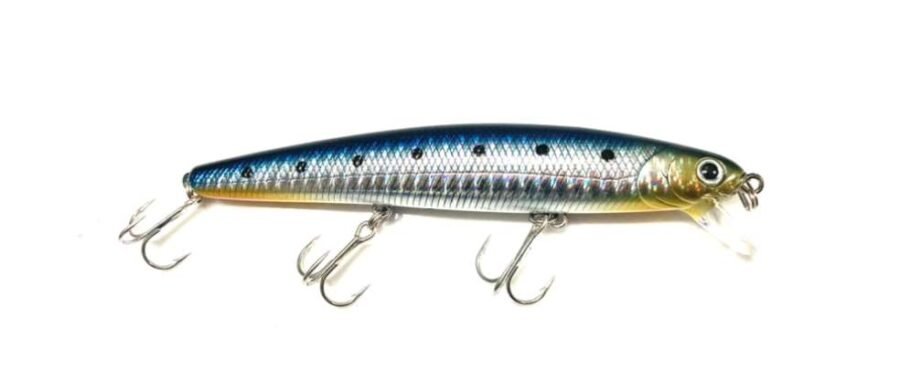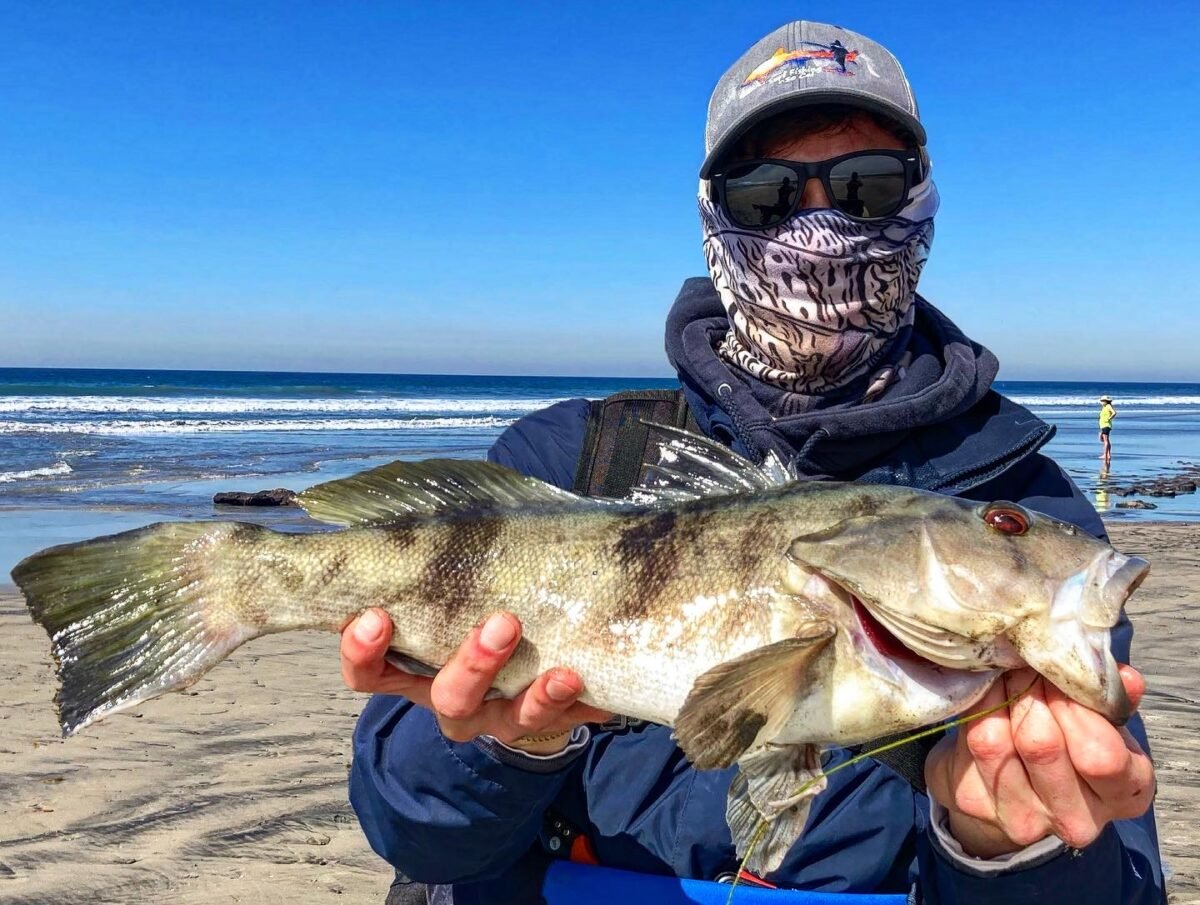Surf Fishing For Calico Bass: Species Overview and How-To

Navigate to Bottom for: How To Catch Calico Bass From The Beach
Calico Bass Overview
Welcome to California, where the weather’s nice and the fishing is even nicer! California offers a number of different fishing options, from off shore, to rivers, streams and lakes. But the surf tends to get over-looked even though it may offer the best fishing of all the options. Let’s talk about surf fishing in California and more specifically, surf fishing for calico bass in California.
Many anglers (even seasoned surf anglers) don’t quite know that you can target calico bass from the shore in California. Most are accustomed to surf fishing for California corbina, surfperch, spotfin croaker and yellowfin croaker.
Surf fishing for these more well-known species usually entails using sand crabs for bait or grubs, worms, etc. Is surf fishing for calico similar? It can be, but typically no.
| Common Names | Calico, Checker Board, Bass, Calico Bass, Kelp Bass |
| Legal Limit (#) | 5 Bag Limit (in any combination) |
| Legal Size (in) | 14 in |
| Record Size (in/lb) | 28.5 inches/14 pounds, 7 ounces |
| Typical Size Range (in/lb) | 10 to 22-inches |
| Range | Bahia Magdalena, Baja Cailfornia, Mexico – Mouth of the Columbia River |
| Habitat | Rocky/reefy areas with sand mixed in, kelp forrests |
| Bait | Baitfish (sardines, anchovy, grunion), shrimp, crabs, squid, etc. |
The fisheries for kelp bass (calico), barred sand bass, and spotted sand bass (Paralabrax species) remains open year-round. The daily bag and possession limit is five fish in any combination of species. The minimum size limit is 14 inches total length or 10 inches alternate length.
Scientific Name for Calico Bass
Paralabrax Clathratus, Family: Serranidae (sea basses)
Common Names for Calico Bass
Calico, Checker Board, Bass, Calico Bass, Kelp Bass
Range
Kelp bass (calico bass) can be found from the Bahia Magdalena, Baja Cailfornia, Mexico to the Mouth of the Columbia River, but they’re rarely found north of Point Conception, California.
Habitat: Where to Fish for Calicos
You’ll typically find calico bass close to shore in kelp forests, bays, and estuaries. Look for reefs and rocky areas along the shoreline or anywhere that kelp is growing from. Calico bass are ambush predators. They like to hang out in cracks and crevasses and attack their prey when it’s in sight. They can be found at depths up to 70.0 feet (21.3 meters).
Size: How Big Do Calico Bass Get?
Kelp bass can grow up to 72.1 centimeters (28.5 inches) in total length and 6.6 kilograms (14.5 pounds). The record size calico bass was 28.5 inches and 14 pounds, 7 ounces off of Newport beach, Ca.
Life Span
“Slow to grow… let em’ go”. Calico bass are slow growers, take nearly 5 years to grow to maturity (reproduction age) and the oldest recorded kelp bass was 34-years-old.
Calico Bass Reproduction
How do calico bass reproduce? Females release their eggs into the water column where the male bass then fertilize them. Spawning occurs from April through November, peaking in the summer months in kelp beds, reefs and other rocky areas and even in open water. Although, they take a few years to mature, females can spawn multiple times per season.
Bait/Diet for Calico Bass
Their diet includes mostly baitfish (sardines, anchovy, grunion, small perch and more), shrimp, crabs, squid, octopus and other similar prey. As they mature, they feed on more baitfish than crustaceans and other invertebrate, but nothing’s ever totally “off the table”.
Predators
Funny enough, bigger bass are the kelp bass’s main predator. Fish like giant black seabass, white seabass along with seals are all to be feared in the world of a calico.
Fishery
Prior to 1953, commercial fishing was allowed, but but due to overfishing combined with the slow growth of the calico bass, commercial fishing for kelp bass was banned. Now, recreational take only is allowed with the size and limit restrictions mentioned earlier.
How to Catch Calico Bass from the Beach
You’ve got a couple options when it comes to surf fishing in California for calico bass. You can either use lures or bait. I’ve heard many experienced surf fishermen mention that they think low tide is the best when they want to throw lures. I’ve always been a big believer that it depends on the spot you’re fishing. Some spots are good for high tide, others are good for low tide. But recently, I’ve begun to see some validity in the assumption.
You see, there are a couple spots that I have that I like to throw lures at a medium to higher tide, but they’re unique. I recall reading the book, California Surf Fishing: The Hunt for Big Fish, and it stated that low tides were better for lure fishing and high tides were better for bait fishing. But why? It was just an observation, so I took it lightly as I wasn’t offered any reasoning behind the theory. I think I might know why though.
Low Tide = Lure Fishing
When fishing for calico, you’ll want to find those reefy or rocky areas near the shoreline (mentioned in the habitat section) and fish those areas at tidal heights where your desired structure is submerged but within casting distance. Typically, low tide offers more hard structure in the proper position and depth than high tide does but it does still vary per location.
One thing that doesn’t necessarily vary per location is the vegetation that grows from these areas with hard structure. Fish love hard structure in the surf, even more so, they love the vegetation that grows from the hard structure.
At high tide, this vegetation is out of casting range because it only grows where it’s almost always submerged and receiving nutrients. At low tide though (especially negative tides), that vegetation might start to get exposed and often, it’s within casting range. So, since high tides submerge areas of the beach that are often exposed and dry, there typically isn’t much vegetation, nutrients, cover, bait etc. in these areas.
Along with the reasoning mentioned above, low tides and tides that are falling tend to offer lower surf and calmer conditions making it easier for anglers to control their lures.
Surf Fishing for Calico Bass with Lures: Gear and Tackle
- Rod: Okuma SST-S-902HA – 1/2-2oz | 10-30lb | 9ft | H | MF
- Reel: Penn Spinfisher VI (3500 or 4500)
- Main Line: 30-pound braid
- Leader Line: 30-pound mono
- Lure Options:
- Lucky Craft FM 110 (jerkbait)
- Keitech Fat Swing Impact (4.8″) | Warbaits 0.5-ounce Weedless Jighead
- BioSpawn ExoSwim (4.75″) | Mustad KVD Grip Pin Swimbait Hook (5/0 | 1/8oz) (T Rigged)
High Tide = Bait Fishing
So, if low tides are great for lures, what makes high tides good for surf fishing with bait? Well, I haven’t tested this one out for myself, but I have a theory. Firstly, you can ramp up your gear a little more when fishing with bait because you aren’t constantly casting. This allows you to cast much further than you typically cast a lure which helps you reach the vegetation and other desirable structure. Some anglers will go from what I mentioned above for lures to the following for bait fishing.
Surf Fishing for Calico Bass with Bait: Gear and Tackle
- Rod: Fiblink Moonsniper (12 or 13 feet)
- Reel: Penn Spinfisher VI 4500 to 6000 (II or III)
- Mainline: 50-pound braid
- Topshot/Leader: 50-pound nylon coated mono
- Weights: 4 ounce bank weight
- Hook: 3/0 hook
But secondly, the higher surf that comes with higher or rising tides can churn up all sorts of bait which can start a feeding frenzy for fish that are looking for a scavenger meal. Which… is ideal if you’re fishing with bait.
Best Bait for Calico
As mentioned above, shrimp, crabs, squid, octopus and other similar prey are in their appetite. You can also use frozen grunion or other similar baitfish and you’ll see okay results. I’ve had success on mussel meat, shrimp, and tuna collar.



Hi Nick, thanks for the article. I have had great luck catching these at low tide this year using squid. As you mention, low tide is great because the structure is a lot more accessible. Question: what are your thoughts on how they rank in terms of taste? Also, I have seen mixed guidance also on when you are allowed to keep them.
I hooked a very large one a few weeks ago and thought the taste quality was quite good. Thanks,
Mark
Hey Mark! Good to hear from you. I have eaten them a couple times and I’d say they’re a nice clean white fish. I’d say corbina, spotfin, calico, guitarfish are all very good eating and I can’t necessarily rate one over the other. However, after learning how long they take to mature, I release the vast majority of the ones that I catch (still keep here and there though).
Thanks for touching base and good to see you still slaying!
-Nick
I noticed that you didn’t discuss rod holders that are useful(nesessary) to hold the 12-13’ surf rod when bait fishing.Istill have a couple of custom aluminum rod holders that I used during the thirty plus years that my wife &I fished for calicos at Point Dume. Like your long rod it’s 13’ long three piece Kencore fiberglass rod.
Good point! Does yours work well in rocky areas?